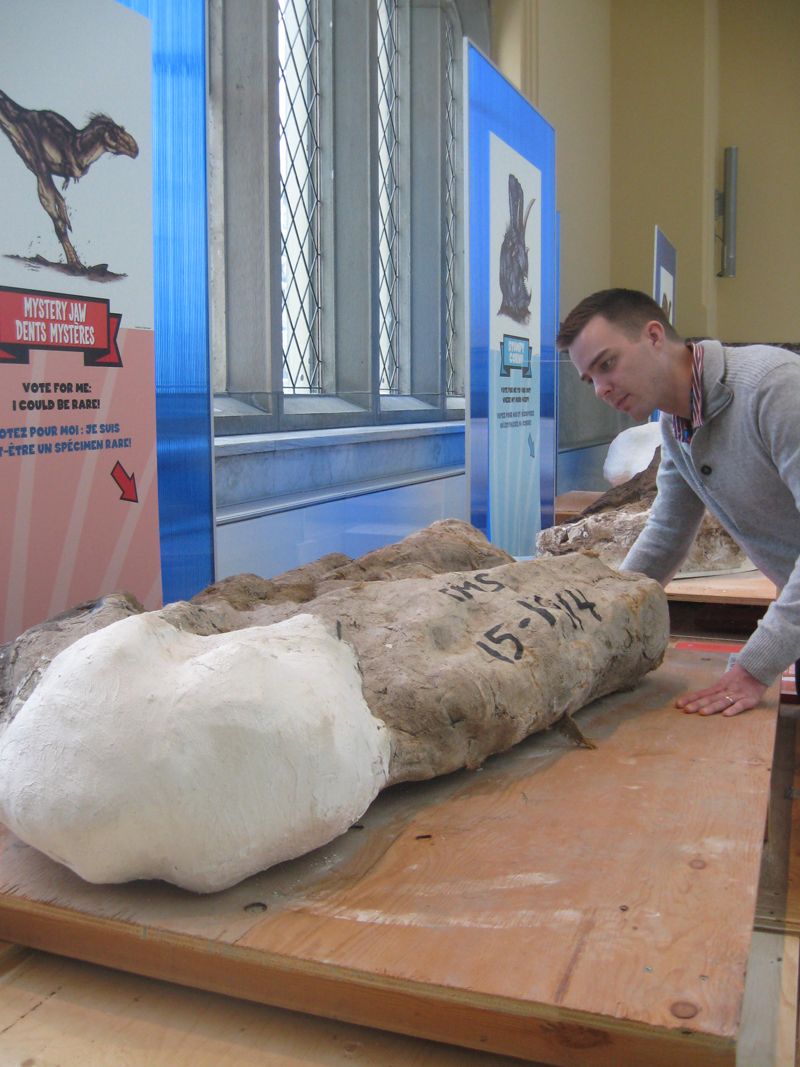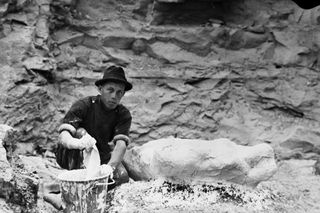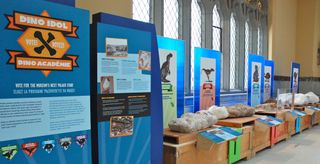'Dino Idol': Vote For Fossil to Be Unveiled

Canada's next rock star may be between 71 million and 75 million years old — and it won't be music that propels him or her to fame.
The Canadian Museum of Nature has launched a contest called "Dino Idol," in which the public can vote on which of five dinosaur fossils that have been tucked into storage for the past century will see the light of day.
Visitors to the Ottawa facility can view a temporary exhibit of the five specimens, still in their boulder-size "jackets" of burlap, plaster and surrounding rock material, and pick the one to crack open. Based on the labels attached to each specimen — the only information to suggest what paleontologists will find inside — options range from a snarly tyrannosaurid to a more placid duckbill.
"Usually, when the public goes to a museum, they'll see the dinosaurs on display. They'll see the fruits of our labor, so to speak, but they don't see what goes on [beforehand]," said Jordan Mallon, a post-doctoral fellow and dinosaur expert who joined the museum recently.
"When it comes to opening a jacket, or even what these jackets are, they often don't know about the research that will go on all these dinosaur fossils."
Most of the dinosaurs were unearthed in Dinosaur Provincial Park, a UNESCO World Heritage Site that bills itself as "one of the world's richest dinosaur fields." [See Photos of the Park & Hidden Dinosaurs]
Paleontologists still wonder how more than 40 dinosaur species thrived during the same period, between 75 million and 76.5 million years ago, in an area less than 29 square miles (75 square kilometers) in size, Mallon said.
Sign up for the Live Science daily newsletter now
Get the world’s most fascinating discoveries delivered straight to your inbox.
The park was a treasure trove for fossil hunters in the early 1900s, particularly for the Sternberg family. Using horses and scows, Charles Sternberg and his sons brought the five Dino Idol fossils (and many others) out of the wilderness between 1912 and 1924.
The family then shipped the fossils by train to Ottawa, about 1,860 miles (3,000 kilometers) east.

Given the Sternbergs' prolific work for the Geological Survey of Canada, it wasn't much surprise that some fossils are still unopened nearly a century later, said Mallon, who did his doctoral research at the University of Calgary in western Canada, which is relatively close to the dinosaur park.
"Often the Sternbergs would go out in the field and collect 20 and 30 dinosaurs," Mallon said. "Given that each one of those will usually take somewhere on the order of one to five years to prepare, and they had many field seasons, [the fossils] just added up."
Here are the five choices for the next paleo-star:
- A mystery jaw from a tyrannosaurid, a carnivorous dinosaur, collected in 1914 that may belong to earlier cousins of Tyrannosaurusrex: Gorgosaurus libratus or Daspletosaurus torosus.
- The skull of a horned dinosaur, possibly the rare Arrhinoceratops, which was collected in 1924.
- The skeleton of a duck-billed dinosaur called Edmontosaurus regalis.
- The skull of a hadrosaur, or a duck-billed dinosaur, found in 1914. The rest of its body likely washed away long ago.
- The hips, tail and bony club of an ankylosaur, possibly from the species Euoplocephalus tutus, collected in 1915.
Deadline for voting in the Dino Idol contest is March 17, and the winner with the most votes will be announced March 19.

Mallon isn't sure if there will be a Dino Idol 2. He does, however, hope to have a greater say in which fossil will be opened next.
"We can't always let the public decide which one to view," he joked.
Follow Elizabeth Howell @howellspace, or Live Science on Twitter @livescience. We're also on Facebook& Google+.

Elizabeth Howell was staff reporter at Space.com between 2022 and 2024 and a regular contributor to Live Science and Space.com between 2012 and 2022. Elizabeth's reporting includes multiple exclusives with the White House, speaking several times with the International Space Station, witnessing five human spaceflight launches on two continents, flying parabolic, working inside a spacesuit, and participating in a simulated Mars mission. Her latest book, "Why Am I Taller?" (ECW Press, 2022) is co-written with astronaut Dave Williams.











